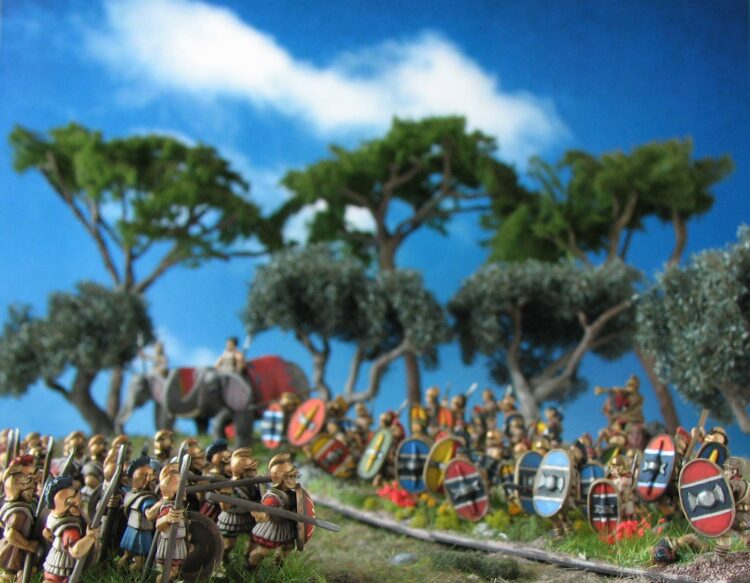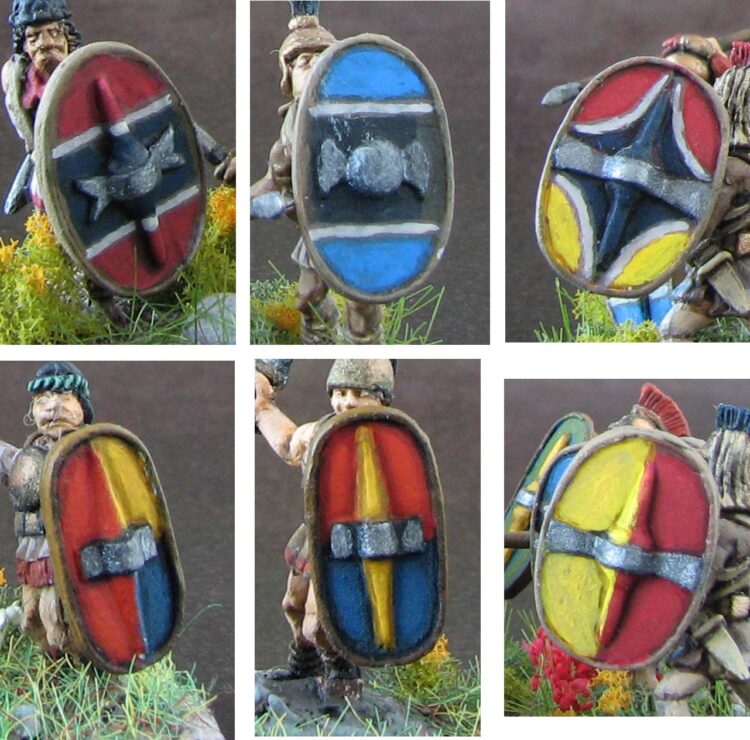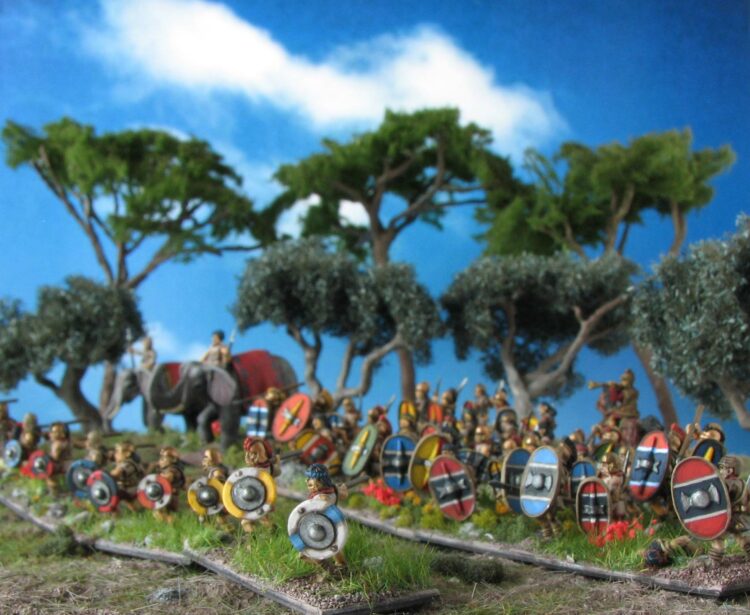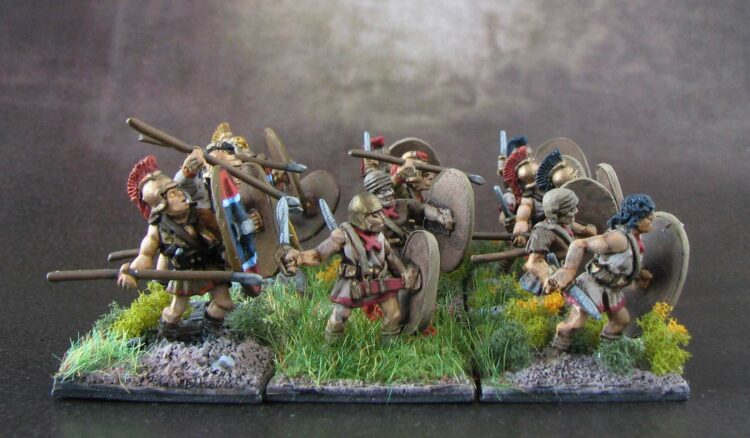Ancient Iberia and Carthage had a long-standing relationship. May it be trading relations, cultural exchange or military support. Even more so when Carthage expanded into Iberian territory in the aftermath of the First Punic war to establish a permanent presence and exploit its riches and man power for the dawning conflict with Rome.
The Carthaginians relied heavily on foreign contingents in their armies, with Iberian troops being no exception. They supplied both lightly armed and medium infantry and formed a major element of a great many Carthaginian armies throughout the ages.
In this post I will focus on my mix of Xyston and Corvus Belli Iberian medium infantry, commonly known as Scutati. They are named aptly after their oval shield, the scutum or its greek equivalent thureos. A historical introduction will be followed by some painting advise.
Historical Background
Ancient Iberia occupied roughly what we know nowadays as Spain and Portugal, with a variety of tribes inhabiting the peninsula.
Appian describes the extend of Iberia in his work on Spanish history:
The Pyrenees mountains extend from the Tyrrhenian sea to the Northern ocean. The eastern part is inhabited by Celts, otherwise called Galatians, and more lately Gauls. From this part westward, beginning at the Tyrrhenian sea and making a circuit by way of the Pillars of Hercules to the Northern ocean, the Iberians and Celtiberians dwell. Thus the whole of Iberia is sea-girt, except the part embraced by the Pyrenees, the largest and perhaps the most precipitous mountains in Europe.
App. Hisp. 1.1-3
Strabon speaks of it as a”fruitful land, abounding in all good things” (Strab. 3.2.8 ) and especially so in metals of all kinds: “Turdetania, however, and the surrounding districts surpass so entirely in this respect, that however you may wish, words cannot convey their excellence. Gold, silver, copper, and iron, equal in amount and of similar quality, not having been hitherto discovered in any other part of the world” (Strab. 3.2.8 ). It is no wonder that both Rome and Carthage had an interest in this area, knowing of the spoils the land would afford them.
Divided yet strong
Strabon proceeds with a tendentious assessment of the characteristics of the Iberians at large, providing an explanation why the Iberians were subdued by multiple people and never formed a confederacy or similar supra-tribal structures.
The settlement of the Grecians amongst these barbarous nations may be regarded as the result of the division of these latter into small tribes and sovereignties, having on account of their moroseness no union amongst themselves, and therefore powerless against attacks from without.
This moroseness is remarkably prevalent amongst the Iberians, who are besides crafty in their manner, devoid of sincerity, insidious, and predatory in their mode of life; they are bold in little adventures, but never undertake any thing of magnitude, inasmuch as they have never formed any extended power or confederacy. If they had had but the will to assist each other, neither could the Carthaginians by making an incursion have so easily deprived them of the greater part of their country, nor before them the Tyrians, then the Kelts, now called the Keltiberians and Berones, nor after these the brigand Viriathus, and Sertorius, nor any others who desired power.
Strab. 3.4.8
Modern ideas of national identity and the nation-state cannot be transferred to ancient people, but there is surely a distinction between the different people in the mediterranean and their views on belonging and cohesion. We might have the Iberians on the one hand with only temporary affiliations and alliances, bound to a specific leader (such as Hannibal) and on the other hand the surprising cohesion of Roman citizens, but also some of their allies, witnessed during the long second half of Hannibal’s invasion of Italy and the lack of upheaval amongst the Roman socii.
However, we must also take into consideration Strabon’s bias and pro-Roman point of view. Depicting the Iberians as unorganised and inapt guerilla warriors can be seen as a strategy to justify subjugation of a lesser people: mere barbarians. Nevertheless confederacies of tribes to oppose an enemy did exist, as the Romans learnt first hand when faced with Indibilis’ and Mandonius’ rebellion in 206 (Liv. 28.31). Queseda (2011, 234) suggests either a timocratic civic militia or an army based on clientelae of major leaders. In combination with other accounts pitched battles seem to have been much more common than small-scale raids and ambushes (see Queseda, 2011, 228). The Romans suffered heavy casualties in these field battles, the Iberians giving no ground to the Romans. However, these confederacies never survived the death of their leader or lasted a long period of time.
Valued mercenaries
Being “esteemed to be the most warlike barbarians that now are” (Thuc. 6.90) and having only limited internal cohesion it is only fitting that the Iberians were often seen as mercenaries in foreign services. Passages in the ancient sources naming Iberian mercenaries are numerous and reach back well into the 5th century BCE (Hdt. 7.165 ). They were employed by the Carthaginians during the siege of Syracus in Sicily in 397 BCE (Diod. 13.110.5), but played also a role later on in the mercenary rebellion in the aftermath of the First Punic War (Plb. 1.67) in 241 BCE and joined in equal measure forces with the Romans and Carthaginians during the Second Punic War (Plb. 3.33 and Plb. 3.99)
Polybios provides a surprisingly detailed enumeration of Iberian troops being deployed around the Mediterranean in preparation for Hannibal’s invasion of Italy,
for the fact is that I myself found on Lacinium a bronze tablet, which Hannibal had caused to be inscribed with these particulars when he was in Italy; and holding it to be an entirely trustworthy authority for such facts, I did not hesitate to follow it.
Plb. 3.33
In as much his claims are true cannot be decided with certainty, but as always we have to be careful with numbers in ancient sources. Nevertheless one can get an impression of the different theatres of war Iberian troops were used in and the multiethnic make-up of Carthaginian armies:
Thirdly, he [Hannibal] took precautions for the security of Libya, by selecting with prudent skill certain soldiers from the home army to come over to Iberia, and certain from the Iberian army to go to Libya; by which interchange he secured cordial feeling of confidence between the two armies.
The Iberians sent to Libya were the Thersitae, the Mastiani, as well as the Oretes and Olcades, mustering together twelve hundred cavalry and thirteen thousand eight hundred and fifty foot. Besides these there were eight hundred and seventy slingers from the Balearic Isles, whose name, as that of the islands they inhabit, is derived from the word ballein, “to throw,” because of their peculiar skill with the sling. Most of these troops he ordered to be stationed at Metagonia in Libya, and the rest in Carthage itself. And from the cities in the district of Metagonia he sent four thousand foot also into Carthage, to serve at once as hostages for the fidelity of their country, and as an additional guard for the city.
With his brother Hasdrubal in Iberia he left fifty quinqueremes, two quadriremes, and five triremes, thirty-two of the quinqueremes being furnished with crews, and all five of the triremes; also cavalry consisting of four hundred and fifty Libyophenicians and Libyans, three hundred Lergetae, eighteen hundred Numidians of the Massolian, Massaesylian, Maccoeian, and Maurian tribes, who dwell by the ocean; with eleven thousand eight hundred and fifty Libyans, three hundred Ligures, five hundred of the Balearic Islanders, and twenty-one elephants.
Plb. 3.33
The beauty of collecting an Iberian army is their versatility. Contingents can easily be used in quite different theatres of war and in different periods of time. Allied with Rome, Carthage or eastern city-states they will see a lot of use. Naturally they can be used on their own to depict inter-tribal warfare or field battles against Roman or Carthaginian armies. Finally, Viriathus’ Lusitanian rebellion and later Sertorius’ fight against the Romans are interesting conflicts Iberian troops can be used in, too.

The Scutatus’ Panoply
Thanks to a rich corpus of written sources and archeological as well as figurative evidence we can reconstruct the basic appearance and way of fighting of the Scutati. The reliefs of Osuna come to mind or the vase paintings of Liria. In effect making it easier for miniature companies to produce accurate representations and for the painter to base his decisions on more than guesswork.
Naturally this does not imply that they were a uniform body of troops. Much rather in the view of their contemporaries a shared use of a specific defensive weapons distinguished them from other combatants. For instance Livius uses the term ‘scutatus‘ for any troop type armed with an oblong shield (Liv 28.2.10; 33.14.5). Polybios’ description of the Iberian contingents at Cannae can serve as another example and provides more details about the Iberian Scutatus:
The shield (θυρεὸς) of the Iberians and Celts was about the same size, but their swords were quite different. For that of the Roman can thrust with as deadly effects as it can cut, while the Gallic sword can only cut, and that requires some room. And the companies coming alternately,—the naked [unamoured] Celts, and the Iberians with their short linen tunics bordered with purple (περιπόρφυρος) stripes, the whole appearance of the line was strange and terrifying.
Plb. 3.114
Offensive weapons
Polybios does not call the Iberian sword ‘Roman’, this is an addition of the translator. Other translations (Loeb) insert ‘Spaniard’. This leaves open if Polybios describes here a so-called Falcata, often associated with the Iberian warrior, or rather the gladius hispaniensis, presumably well-known to Polybios from his own experience. Archeological evidence suggests that this long straight sword with parallel edges and a short point had its resurgence during the Second Punic War in Iberia (Quesada, 2011, 218ff.).
It is similar to sword types used in Gaul and Celtiberia earlier and was adopted by the Romans after the war due to its superior qualities. Interestingly enough it did not supplant the Falcata in Iberia entirely. Quesada (2011, 218) argues based on Polybios that the gladius hispaniensis was used heavily by Iberians in the service of Rome and Carthage, due to being better suited for hand-to-hand combat. This is surely possible and would explain exposure of Romans to the new sword type, but an exclusive use of this type of sword by Iberians in Carthaginian service is less likely, but rather a mixture of types could be assumed.
A short biglobular dagger with a tapering, triangular blade of Celtiberian origin also appeared during the second half of the 3rd century BC.
Defensive weapons
In Polybios their shields appear similar to Celtic equivalents size-wise. However, through reliefs we can get a good idea about their shape, which was more oval with a ‘butterfly’ shaped metal boss. Given that the rim of the shield did not survive the ages, but can be seen in depictions, it is well possible that it was made of leather or another organic material.
While older scholarly literature assumed a celtic origin of the thureos (Stary, 1981) and subsequent introduction to Iberia, this seems now less likely looking at textual, figurative and archeological evidence. Similar shield forms were used in Etruria, too. This poses the question if they originated there, were influenced by Celtic shield forms, or were developed independently (Eichberg, 1987, 183ff; Queseda, 2011, 222). The thureos was also used in Greek contexts (Pausanias 8.50.1; Plb. 10.29), potentially introduced by Galatians.
According to Queseda (2011, 223ff.) depictions of oval shields on Iberian vases and in reliefs cannot be dated earlier than 240 BC, but are more likely to have originated after the establishment of a Carthaginian presence in Iberia. As we don’t have any earlier depictions as of now and assuming the dating of the figurative depictions is correct, this line of thought is convincing.
Interestingly Livy asserts that different tribes, in his report Lacetani and Suessetani, would recognise each other through their arms and standards (Liv. 34.20.6). This could hint at the existence of different shield emblems, as other pieces of equipment might have been quite similar, with the shield design allowing tribal identification. However, this is at most an educated guess, if not speculation.
Another defensive weapon introduced by the Carthaginians or alternatively Iberian mercenaries in Carthaginian service is the Montefortino type helmet. Being cheap, efficient and easy to mass produce it was widely used by Romans, Carthaginians and Iberians alike (Queseda, 2011, 220).
Distinctive garb?
Finally we have a description of their distinctive tunics, bordered with purple (περιπόρφυρος). If Polybios refers here to a hue that resembles Tyrian purple, famously extracted from sea snails (Plin. Nat. 9.62), is not quite clear. Being an expensive luxury item connoting wealth and status, it is unlikely that it was used to dye the tunics.
Nevertheless, Tyrian purple is a red purple, so tunics bordered in crimson or scarlet are a possibility, too. This is further suggested by Iberia being famous for its dye production (Strab. 3.4.16), among it madder and kermes (Strab. 3.2.6). The former can be used to achieve a variety of red tones, depending on what it is mordanted with, the latter achieving a scarlet tone. Vermilion or cinnabar was also famously mined in Iberia, but due to its scarcity and toxicity hard to procure (Plin. Nat. 33.40) especially so in pre-roman times. Madder might be the most likely candidate as it was easy to procure and could achieve a scarlet or crimson shade.
In as much this description can be understood as indicating a uniformity among the Iberians is questionable. It might well be that this fashion was prevalent among Iberians of different tribes or of a specific region Hannibal recruited in, yet it might go too far to assert that every Iberian wore a similar tunic.
15mm Scutati by Xyston and Corvus Belli
Both Xyston and Corvus Belli miniatures feature the thureos (the latter potentially resembling a more celtic type), biglobular dagger, falcata and montefortino helmet as well as sinew/leather caps (ostensibly following depictions on the Osuna reliefs) alongside the typical pectoral and double crossed belt. This suggests a Second Punic War context and makes the miniatures less suitable for earlier periods.

The sculpting is excellent with both manufacturers, with crisp details, sensible poses and good proportions. The Xyston miniatures are markedly taller, but they still work fine in a unit mixed with the smaller Corvus Belli. The latter have generous amounts of flash and in some cases slight casting artefacts, such as warped faces. However, nothing too severe. One can hope that after the line is now discontinued, that they will reissue them and renew the molds in some point. The Xyston Scutati have almost no flash and no casting artefacts.
I painted the tunics in a variety of off-white, beige and brown tones with crimson stripes. I also added blue stripes for variety or left some tunics without any stripes.
The shield patterns are inspired by the Liria vase and Osuna reliefs and are mostly a combination of geometric patterns, while the colours used are naturally an educated guess.

I hope you found this introduction to the Iberians and the Scutati interesting and might be inspired to read more about their culture or paint some yourself. If you have anything to add or would like to discuss some of the issues raised in the text please do not hesitate and comment below.
References
Primary Sources
Appian. The Foreign Wars. Horace White [Trans.]. New York: Macmillan, 1899.
Aristotle. Aristotle in 23 Volumes, Vol. 21, H. Rackham [Trans.]. Cambridge, MA: Harvard University Press; London: William Heinemann Ltd. 1944.
Diodorus Siculus. Diodori Bibliotheca Historica, Vol 1-2. Immanel Bekker. Ludwig Dindorf. Friedrich Vogel. in aedibus B. G. Teubneri: Leipzig, 1888-1890.
Herodotos, Histories. A. D. Godley [Trans]. Cambridge: Harvard University Press, 1920.
Livy. Books XXVIII-XXX With An English Translation. Cambridge, MA: Harvard University Press, 1949.
Livy. History of Rome. Canon Roberts [Trans.]. New York, New York: E. P. Dutton and Co. 1912.
Pausanias. Pausanias Description of Greece. W.H.S. Jones and H.A. Ormerod [Trans.]. Cambridge, MA: Harvard University Press; London: William Heinemann Ltd. 1918.
Pliny the Elder. The Natural History. John Bostock [Trans.]. London: Taylor and Francis, 1855.
Plutarch. Plutarch’s Lives. with an English Translation by. Bernadotte Perrin [Trans]. Cambridge, MA: Harvard University Press; London: William Heinemann Ltd. 1919.
Polybius. Histories. Evelyn S. Shuckburgh [Trans.]. London, New York: Bloomington, 1962.
Strabo. The Geography of Strabo. Literally translated, with notes, in three volumes. London: George Bell & Sons, 1903.
Thucydides. Thucydides translated into English; with introduction, marginal analysis, notes, and indices. Volume 1. Benjamin Jowett [Trans]. Oxford: Clarendon Press, 1881.
Xenophon. Xenophon in Seven Volumes, 1 and 2. Carleton L. Brownson [Trans]. Cambridge, MA: Harvard University Press; London: William Heinemann, Ltd.1918-1921.
Secondary sources
Eichberg, M. (1987). Scutum: die Entwicklung einer italisch-etruskischen Schildform von den Anfängen bis zur Zeit Caesars. Frankfurt, Paris, New York.
Quesada Sanz, F. (2011). Military developments in the ‘Late Iberian’ culture (c. 237-c. 195 BC): mediterranean influences in the far west via the Carthaginian military. In: N. Sekunda, A. Noguera (eds.) Hellenistic Warfare I. Proceedings Conference Torun (Poland), October 2003. Valencia, 2011.
Stary, P. (1981). Ursprung und Ausbreitung der eisenzeitlichen Ovalschilde mit spindelförmingem Schildbuckel. In: Germania 59 (1981), 287-306.
Online Database of artefacts
Red Digital de Colecciones de Museos de España
This site and database is in Spanish, but provides access to photographs of the collections of a number of Spanish museums. For the Osuna reliefes just search for: Osuna relieves.








Wonderful post, a lot of work and inspiration. The miniatures are perfect! Thanks for sharing – greetings from Portugal 🙂
Thank you Rogério. Glad you like the post and that it inspired you.
Gorgeous pictures and awesome historical job…that’s a great post, no doubt!
Thank you very much for your comment. I am glad you like both the paint job and the historical background.
Excellent series of posts linking historical background with well painted miniatures.
Thank you very much for your comment! I am glad you enjoy the mixture. There are still quite a number in the pipeline, but in the end this should be a good resource for wargamers planning to start a Carthaginian army.
Thanks for sharing your research, I really enjoy those posts! And I especially appreciate that you include a bibliography, this is missing too often and I like to get some bearings on what to read if I approach a new subject.
And – as always – great job on the figures!
You are welcome. I prefer to read a text that gives references too, especially if it is related to ancient history. I will actually add to the list when I get some more interloans in. There are some very interesting publications in Spanish I would like to look at.
Awesome job!
Thank you. Much obliged!
Great post. I love this kind of research when I do historical minies..
I absolutely agree. It really makes historicals so much more appealing :).
Nice job and post.
Thank you very much! Glad you like it!
Apart from the excellent background information which shows me you are very well read the bit that stands out for is the beutiful colours this period had for it uniforms. It gets a bit dull painting WWII all the time and your colour pallets makes be quiet jealous. Very good post 🙂
Thank you! The research is always fun for such projects and I learnt a lot about current theories while reading up on the subject.
The colourful apperance si actually one of the things I like most about ancient armies. Lack of uniformity and in Carthage’s case a reliance on quite different mercenaries makes it a colourful and varied army to collect. However, same goes for other ancient armies, especially if it comes down to shield designs and tunic colours. I find it always interesting to see how relatively easy it was to achieve some colours, even though they might not have been very light fast. The whole idea of the “white and classy” antiquity is surely outdated, I think more like India :).